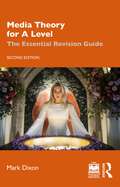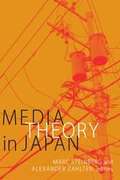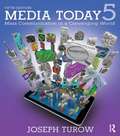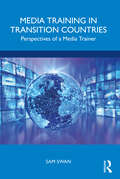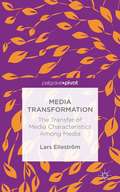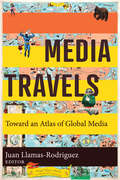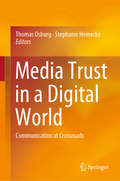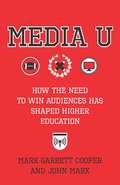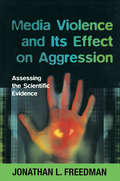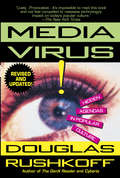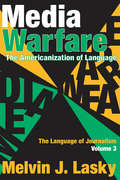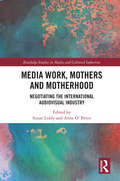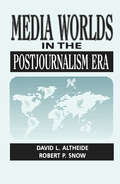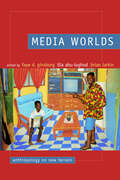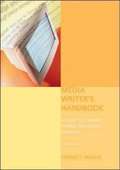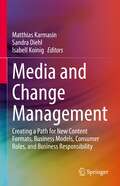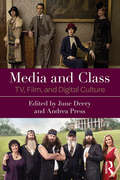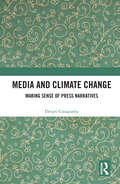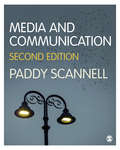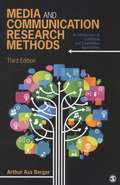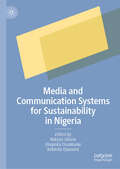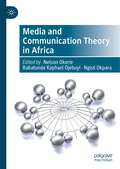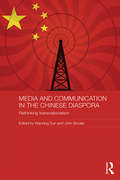- Table View
- List View
Media Theory for A Level: The Essential Revision Guide
by Mark DixonMedia Theory for A Level provides a comprehensive introduction to the 19 academic theories required for A Level Media study.From Roland Barthes to Clay Shirky, from structuralism to civilisationism, this revision book explains all the core academic concepts students need to master to succeed in their exams. Each chapter contains comprehensive explanations of the academic ideas and theories specified for GCE Media study as well as practical tasks, higher level ‘challenge activities’, glossaries, reference tables and revision summaries.The second edition of this best-selling guide features: Updated and revised chapters and exemplars, reflecting the new A Level Media specification (AQA, Eduqas, OCR and WJEC). Overviews of core areas and potential approaches that could be taken in exam responses. Overviews of secondary theory that can be used in responses. This book is key reading for teachers and students of A Level Media Studies and is also a useful resource for GCSE students.Media Theory for A Level is accompanied by the www.essentialmediatheory.com website that contains a wide range of supporting resources including revision flashcards, worksheets and more exemplar applications of theory to current set texts.
Media Theory in Japan
by Alexander Zahlten Marc SteinbergProviding an overview of Japanese media theory from the 1910s to the present, this volume introduces English-language readers to Japan's rich body of theoretical and conceptual work on media for the first time. The essays address a wide range of topics, including the work of foundational Japanese thinkers; Japanese theories of mediation and the philosophy of media; the connections between early Japanese television and consumer culture; and architecture's intersection with communications theory. Tracing the theoretical frameworks and paradigms that stem from Japan's media ecology, the contributors decenter Eurocentric media theory and demonstrate the value of the Japanese context to reassessing the parameters and definition of media theory itself. Taken together, these interdisciplinary essays expand media theory to encompass philosophy, feminist critique, literary theory, marketing discourse, and art; provide a counterbalance to the persisting universalist impulse of media studies; and emphasize the need to consider media theory situationally. Contributors. Yuriko Furuhata, Aaron Gerow, Mark Hansen, Marilyn Ivy, Takeshi Kadobayashi, Keisuke Kitano, Akihiro Kitada, Thomas Looser, Anne McKnight, Ryoko Misono, Akira Mizuta Lippit, Fabian Schäfer, Marc Steinberg, Tomiko Yoda, Alexander Zahlten
Media Today
by Joseph Turow"Turow's Media Today: Mass Communication in a Converging World, now in its fifth edition, chooses [a] cutting-edge option. This is a student-friendly publication, offering aids such as definitions of key terms, colourful infographics, case studies and end-of-chapter review questions. There's a companion website, too, and a password-protected website for instructors."--Philip Kemp, Times Higher Education Media Today uses convergence as a lens that puts students at the center of the profound changes in the 21st century media world. Through the convergence lens they learn to think critically about the role of media today and what these changes mean for their lives presently and in the future. The book's media systems approach helps students to look carefully at how media is created, distributed, and exhibited in the new world that the digital revolution has created. In this way, Media Today goes beyond the traditional mass communication textbook's focus on consuming media, to give students an insider's perspective on how media businesses operate. How exactly does Google profit from web searches? What will a magazine look like five years from now? Informative and engaging, Media Today, Fifth Edition, is characterized by its focus on: Convergence: In addition to separate chapters on the Internet and the Video Games industry, coverage of convergence and its impact is incorporated into every chapter. Consumer Education: Media Literacy questions ask students to consider their roles as a media consumer and potential media creator. Comprehensive Media Industry Coverage: Historical timelines in the print book and on the companion website track the development of each media industry, giving students an overview of a particular industry at a glance. Contemporary, Student-friendly Examples: New culture and media boxes help students think about the impact of media industries on their own lives and globally. Joseph Turow--who has been teaching Intro to Mass Communication for well over a decade--demonstrates the many ways that media convergence and the pervasiveness of the Internet have blurred distinctions between and among various media. From newspapers to video games or social networking to mobile platforms, Media Today prepares students to live in the digital world of media.
Media Today: Mass Communication in a Converging World
by Joseph TurowMedia Today uses convergence as a lens that puts students at the center of the profound changes in the 21st century media world. Through the convergence lens they learn to think critically about the role of media today and what these changes mean for their lives presently and in the future. The book’s media systems approach helps students to look carefully at how media content is created, distributed, and exhibited in the new world that the digital revolution has created. From newspapers to video games and social networking to mobile platforms, Media Today prepares students to live in the digital world of media.
Media Training in Transition Countries: Perspectives of a Media Trainer
by Sam SwanThis book explores the impact of, and lessons learned from, media development and training programs sponsored by the US government and non-governmental organizations in countries transitioning to democracy. Recognizing the importance of establishing a free press and a free market economy in newly democratic societies, this book examines the training of journalists and media managers in selected countries in Eastern Europe, Africa, Asia, the Middle East, and South America. Drawing on the author’s and other media trainers’ experiences over a 25-year period, this book provides important insights into tailoring training programs to specific regions and countries. Case studies describe training in radio and television management, broadcasting, and media sustainability, and are contextualized against the cultural and historical backgrounds of each region. Media Training in Transition Countries will be of interest to media trainers, government and nongovernment agencies, and scholars and students of international journalism and development.
Media Transformation: The Transfer of Media Characteristics Among Media (Palgrave Pivot)
by Lars ElleströmThis is a methodical study of the material, mental limit and possibilities of transferring information and media characteristics among dissimilar media. Ellestrom proposes a model for pinpointing the most vital conceptual entities and stages in intermedial transfers with different media that have common traits that enable systematic comparison.
Media Travels: Toward an Atlas of Global Media
by Juan Llamas-RodriguezMedia Travels: Toward An Atlas of Global Media fills a significant gap in global media scholarship by offering short, readable articles covering different types of media from around the world. Through careful and informed analysis, these eleven accessibly written chapters illustrate the particularities of different media practices and situate them within social, historical, and geographical contexts. Examples range from South African video games to Korean TV series popular in Latin America to Indigenous film and media from the US and Canada. Media studies courses, particularly introductory courses, are often narrowly focused on US and Western European canons. Instructors for introductory media studies courses wishing to expand the offerings in their curricula will find in these essays new ways of approaching foundational concepts and issues in the field, including globalization, social difference, and diverse media cultures. Scholars wishing to expand their research into specific media forms or representational issues can also turn to these case studies for approaches from beyond the US. By including a variety of media and several geographical areas, the collection introduces readers to the formal, technological, and cultural diversity of global media studies. Edited by Juan Llamas-Rodriguez with contributions from Anthony Adah and Añulika Agina, Maria Corrigan, Benjamin Han, Anna Shah Hoque, Meryem Kamil, Angelica Marie Lawson, Lilia Adriana Perez Limon, Sonia Robles, Kuhu Tanvir, David Tenorio, and Rachel van der Merwe.
Media Trust in a Digital World: Communication at Crossroads
by Thomas Osburg Stephanie HeineckeThis book examines the shifting role of media trust in a digital world, and critically analyzes how news and stories are created, distributed and consumed. Emphasis is placed on the current challenges and possible solutions to regain trust and restore credibility. The book reveals the role of trust in communication, in society and in media, and subsequently addresses media at the crossroads, as evinced by phenomena like gatekeepers, echo chambers and fake news. The following chapters explore truth and trust in journalism, the role of algorithms and robots in media, and the relation between social media and individual trust. The book then presents case studies highlighting how media creates trust in the contexts of: brands and businesses, politics and non-governmental organizations, science and education. In closing, it discusses the road ahead, with a focus on users, writers, platforms and communication in general, and on media competency, skills and education in particular.
Media U: How the Need to Win Audiences Has Shaped Higher Education
by John Marx Mark Garrett CooperAre homecoming games and freshman composition, Twitter feeds and scholarly monographs really mortal enemies? Media U presents a provocative rethinking of the development of American higher education centered on the insight that universities are media institutions. Tracing over a century of media history and the academy, Mark Garrett Cooper and John Marx argue that the fundamental goal of the American research university has been to cultivate audiences and convince them of its value.Media U shows how universities have appropriated new media technologies to convey their message about higher education, the aims of research, and campus life. The need to create an audience stamps each of the university’s steadily proliferating disciplines, shapes its structure, and determines its division of labor. Cooper and Marx examine how the research university has sought to inform publics and convince them of its value to American society, from the rise of football and Great Books programs in the early twentieth century through a midcentury communications complex linking big science, New Criticism, and design, from the co-option of 1960s student activist media through the early-twenty-first-century reception of MOOCs and the latest promises of technological disruption. The book considers the ways in which universities have used media platforms to reconcile national commitments to equal opportunity with corporate capitalism as well as the vexed relationship of democracy and hierarchy. By exploring how media engagement brought the American university into being and continues to shape academic labor, Media U presents essential questions and resources for reimagining the university and confronting its future.
Media Violence and its Effect on Aggression
by Jonathan L. FreedmanThe scientific evidence does not support the notion that TV and film violence cause aggression in children or in anyone else. So argues Jonathan Freedman, based on his findings that far fewer than half of the scientific studies have found a causal connection between exposure to media violence and aggression or crime. In fact, Freedman believes that, taken to a more controversial extreme, the research could be interpreted as showing that there is no causal effect of media violence at all.Media Violence and its Effect on Aggression offers a provocative challenge to the accepted norms in media studies and psychology. Freedman begins with a comprehensive review of all the research on the effect of violent movies and television on aggression and crime. Having shown the lack of scientific support for the prevailing belief that media violence is connected to violent behaviour, he then explains why something that seems so intuitive and even obvious might be incorrect and goes on to provide plausible reasons why media violence might not have bad effects on children. He contrasts the supposed effects of TV violence on crime with the known effects of poverty and other social factors, and discusses the difference between television advertising, which, he argues, does have an effect, and violent programs, which do not. Freedman concludes by noting that in recent years television and films have been as violent as ever and violent video games have become more and more popular, yet during this period there has been a dramatic decrease in violent crime. He argues that this makes it highly implausible that media violence causes aggression or crime.
Media Virus! Hidden Agendas in Popular Culture
by Douglas RushkoffThe most virulent viruses today are composed of information. In this information-driven age, the easiest way to manipulate the culture is through the media. A hip and caustically humorous McLuhan for the '90s, culture watcher Douglas Rushkoff now offers a fascinating expose of media manipulation in today's age of instant information.
Media Warfare: The Americanization of Language (Language Of Journalism Ser.)
by Melvin J. LaskyMedia Warfare is the concluding volume of Melvin Lasky's monumental The Language of Journalism, a series that has been praised as a ""brilliant"" and ""original"" study in communications and contemporary language. Firmly rooted in the critical tradition of H. L. Mencken, George Orwell, and Karl Kraus, Lasky's incisive analysis of journalistic usage and misusage gauges both the cultural and political health of contemporary society as well the declining standards of contemporary journalism.As in the first two volumes, Lasky's scope is cross-cultural with special emphasis on the sometimes conflicting, sometimes mutually influential styles of American and British journalistic practice. His approach to changes in media content and style is closely keyed to changes in society at large. Media Warfare pays particular attention to the gradual easing and near disappearance of censorship rules in the 1960s and after and the attendant effects on electronic and print media. In lively and irreverent prose, Lasky anatomizes the dilemmas posed by the entrance of formerly ""unmentionable"" subjects into daily journalistic discourse, whether for reasons of profit or accurate reporting. He details the pervasive and often indirect influence of the worlds of fashion and advertising on journalism with their imperatives of sensationalism and novelty and, by contrast, how the freeing of language and subject matter in literature--the novels of Joyce and Lawrence, the poetry of Philip Larkin--have affected permissible expression for good or ill. Lasky also relates this interaction of high and low style to the spread of American urban slang, often with Yiddish roots and sometimes the occasion of anti-Semitic reaction, into the common parlance of British no less than American journalists.Media Warfare concludes with prescriptive thoughts on how journalism might still be revitalized in a ""post-profane"" culture. Witty, timely, and deeply learned, the three volumes of The Language of Journalism are a c
Media Work, Mothers and Motherhood: Negotiating the International Audio-Visual Industry (Routledge Studies in Media and Cultural Industries)
by Anne O'Brien Susan LiddyThis interdisciplinary and international volume offers an innovative and critical exploration of the impact of motherhood on the engagement of women in media and creative industries across the globe. Diverse contributions critically engage with the intersections and overlap between the social categories of worker and mother, and the work of media production and maternal caregiving. Conflicting ideas about, and expectations of, mothers are untangled in the context of the working world of radio, film, television and creative media industries. The book teases out commonalities between experiences that are evident across a number of countries, from Hollywood to Bollywood, as well as examining the differences between class, religion, maternal status and cultural frameworks that surround working mothers in various nation states. It also offers some possibilities for ways forward that can improve the lives of women workers who are also mothers. A timely and valuable contribution to international debates on equality, mothers and motherhood in audiovisual industries, this book will be of interest to scholars and students of media, communication, cultural studies and gender, programmes engaged with work inequalities and motherhood studies, and activists, funders, policymakers and practitioners.
Media Worlds in the Postjournalism Era (Communication And Social Order Ser.)
by David AltheideThe concept of media logic, a theoretical framework for explaining the relationship between mass media and culture, was first introduced in Altheide and Snow's influential work, Media Logic. In Media Worlds in the Postjournalism Era, the authors expand their analysis of how organizational considerations promote a distinctive media logic, which in turn is conductive to a media culture. They trace the ethnography of that media culture, including the knowledge, techniques, and assumptions that encourage media professionals to acquire particular cognitive and evaluative criteria and thereby present events primarily for the media's own ends.
Media Worlds: Anthropology on New Terrain
by Lila Abu-Lughod Faye D. Ginsburg Brian LarkinThis groundbreaking volume showcases the exciting work emerging from the ethnography of media, a burgeoning new area in anthropology that expands both social theory and ethnographic fieldwork to examine the way media--film, television, video--are used in societies around the globe, often in places that have been off the map of conventional media studies. The contributors, key figures in this new field, cover topics ranging from indigenous media projects around the world to the unexpected effects of state control of media to the local impact of film and television as they travel transnationally. Their essays, mostly new work produced for this volume, bring provocative new theoretical perspectives grounded in cross-cultural ethnographic realities to the study of media.
Media Writers Handbook
by George T. ArnoldDiscusses common pitfalls in journalistic writing and how to avoid them.
Media and Change Management: Creating a Path for New Content Formats, Business Models, Consumer Roles, and Business Responsibility
by Sandra Diehl Matthias Karmasin Isabell KoinigChange management is not just affected globally by environmental and social conditions, including political and technological changes, but also through convergence, which helps conceptualize change over the past decades. The media industry, in particular, is being challenged by the rise of social media, the crisis of refinancing especially for quality news media, the ‘misinformation epidemic’, and the changing role of legacy media. The evolving nature of media usage and communication, the rise of produsage and influencers, and intermediaries and their personalized algorithmic content are also factors that impact the industry, along with data privacy and privacy management, and the “new responsibilities” of companies such as sustainability, agility and resilience, etc.This book focuses on permanent change management in the media and related industries. It provides insights into the most common and crucial phenomena of media and change management in general, while also revealing some more specific issues brought about by technical and social innovations. The authors expand the meaning of media management beyond the management functions within the industry to include the management of different media. The book serves as a useful guide for researchers, students, and practitioners alike, as they are all affected by change processes.
Media and Class: TV, Film, and Digital Culture (Feminist Cultural Studies, The Media, And Political Culture Ser.)
by June Deery Andrea PressAlthough the idea of class is again becoming politically and culturally charged, the relationship between media and class remains understudied. This diverse collection draws together prominent and emerging media scholars to offer readers a much-needed orientation within the wider categories of media, class, and politics in Britain, America, and beyond. Case studies address media representations and media participation in a variety of platforms, with attention to contemporary culture: from celetoids to selfies, Downton Abbey to Duck Dynasty, and royals to reality TV. These scholarly but accessible accounts draw on both theory and empirical research to demonstrate how different media navigate and negotiate, caricature and essentialize, or contain and regulate class.
Media and Climate Change: Making Sense of Press Narratives
by Deepti GanapathyThis book looks at the media’s coverage of climate change and investigates its role in representing the complex realities of climate uncertainties and its effects on communities and the environment. The book explores the socio-economic and cultural understanding of climate issues, the influence of environment communication via the news and the public response to it. It also examines the position of the media as facilitator between scientists, policy makers and the public. Drawing extensively from case studies, personal interviews, comparative analysis of international climate coverage, and a close reading of newspaper reports and archives, the author studies the pattern and frequency of climate coverage in the Indian media and their outcomes. With a special focus on the Western Ghats, the book also discusses political rhetoric, policy parameters and events which trigger a debate about development over biodiversity crisis and environmental risks in India. This book will be of great interest to scholars and researchers of environmental studies, especially climate change, media studies, public policy and South Asian studies as well as a conscientious citizen who deeply cares for the environment.
Media and Communication
by Paddy ScannellMedia and Communication traces the historical development of media and communication studies in the 20th century. Paddy Scannell explores how the field formed and developed in both North America and in Europe, expertly introducing and explaining a host of essential media thinkers, ideas and concepts along the way. Including a new chapter on media events, this second edition of a classic text provides a comprehensive yet personal – and always accessible – analysis of media and communication theory and history. It is an invaluable resource for students across media and communication studies, cultural studies, and sociology.
Media and Communication
by Paddy ScannellMedia and Communication traces the historical development of media and communication studies in the 20th century. Paddy Scannell explores how the field formed and developed in both North America and in Europe, expertly introducing and explaining a host of essential media thinkers, ideas and concepts along the way. Including a new chapter on media events, this second edition of a classic text provides a comprehensive yet personal – and always accessible – analysis of media and communication theory and history. It is an invaluable resource for students across media and communication studies, cultural studies, and sociology.
Media and Communication Research Methods: An Introduction to Qualitative and Quantitative Approaches 3rd edition
by Arthur Asa BergerThe new edition combines insightful discussions of qualitative and quantitative media and communication research methods as it covers each topic thoroughly in a fun-to-read style. Ideal for beginning research students at both the graduate and undergraduate level, this proven book is clear, concise, and accompanied by just the right number of detailed examples, useful applications, and valuable exercises that are sure to get your students to want to understand, and master, media and communication research.
Media and Communication Systems for Sustainability in Nigeria
by Nelson Okorie Kehinde Oyesomi Oluyinka OsunkunleThis book is a compendium of rigorous and original research, exploring the use of media systems and communication techniques to mitigate sustainable development issues in Nigeria. The novelty of this book project is in line with the Sustainable Development Goals (SDGs), notably education, health, economy, and security. In addition, this book project also explores how specialized areas of communication, such as development communication, health communication, and intercultural communication can be utilized to promote cultural agenda, policy enactments, and national development projects in Nigeria.
Media and Communication Theory in Africa
by Nelson Okorie Babatunde Raphael Ojebuyi Ngozi OkparaThis contributed volume explores theories of media and communication and focuses on providing African perspectives on global conversations. Using broad cases relating to media and communication theories, this book explores socio-cultural issues affecting most modern African societies, providing a conceptual and empirical framework for explicating the potential place of media techniques and structures in Africa. As a good template for understanding and applying communication theories and approaches in the African context, the volume is a priceless asset for Media and Communication scholars.
Media and Communication in the Chinese Diaspora: Rethinking Transnationalism (Media, Culture and Social Change in Asia #Vol. 5)
by John Sinclair Wanning SunThe rise of China has brought about a dramatic increase in the rate of migration from mainland China. At the same time, the Chinese government has embarked on a full-scale push for the internationalisation of Chinese media and culture. Media and communication have therefore become crucial factors in shaping the increasingly fraught politics of transnational Chinese communities. This book explores the changing nature of these communities, and reveals their dynamic and complex relationship to the media in a range of countries worldwide. Overall, the book highlights a number of ways in which China’s "going global" policy interacts with other factors in significantly reshaping the content and contours of the diasporic Chinese media landscape. In doing so, this book constitutes a major rethinking of Chinese transnationalism in the twenty-first century.
